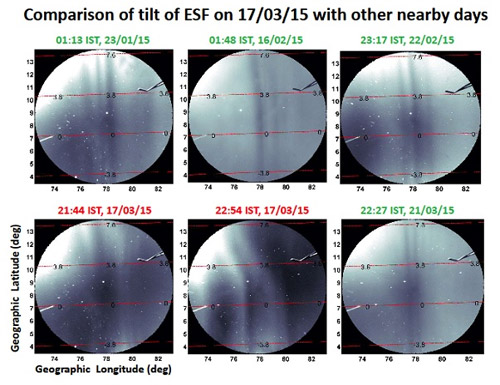A Ph.D. scholar from Indian Institute of Geomagnetism, an autonomous institute under the Department of Science & Technology, has spotted an intriguing asymmetry in the ionospheric structure with respect to the geomagnetic equator,  which could influence satellite and radio signals on which we are so dependent today.
which could influence satellite and radio signals on which we are so dependent today.
IIG has a well-equipped laboratory at Tirunelveli, called Equatorial Geophysical Research Laboratory (EGRL), in the southernmost state of India, Tamil Nadu. This center is close to the geomagnetic equator and hence is privy to studying some equatorial ionospheric phenomena. One such phenomenon is the Equatorial spread-F (ESF), a hierarchy of plasma instabilities in the F-layer of the equatorial ionosphere, also called plumes arises from the turbulent ionospheric plasma during late evening hours.
Sukanta Sau, a Ph.D. candidate, pursuing his Ph.D. under Professor S. Gurubaran at IIG in one of the observational data sets obtained from Tirunelveli, noticed an asymmetry in the plume structure (structure formed when gravitational instability pushes ionospheric plasma after sunset), with respect to the geomagnetic equator. The tilt of the plumes seemed to be large in the Northern Hemisphere compared to the Southern Hemisphere. This was a peculiar feature not reported earlier, has been published in the journal Advancing Earth and Space Science.
Sun has a large influence on the composition of the atmosphere. The energy of the Sun is quite potent and converts many of the common atoms and molecules into plasma, which is a composition of electrons and positive ions in equal proportion. Gravitational instability normally kicks in the ionosphere after sunset and pushes the ionospheric plasma upward, creating a plume-like structure.
The plume structures are called ESF, and they contain lesser density plasma compared to their surroundings. The plume is an anomaly because it is packed with less plasma than the surrounding. Because it is lighter, or less dense, it rises up in the atmosphere due to buoyancy and follows the geomagnetic field lines to map itself to both the hemispheres as it rises in altitude. Seen from the geomagnetic equator, they appear to be symmetric.
The night sky everywhere is dark in the absence of the moon, but even in pitch dark, the night sky lurks a glow that seems imperceptible to the eye, yet can be used to ‘see’ in the dark. This is called the ‘airglow,’ and it reveals many interesting phenomena taking place in the upper layers of the Earth’s atmosphere. This night radiance can be seen and imaged through an all-sky airglow imager (ASAI). This is a very sensitive camera with a large field of view to study the night sky. This instrument provides useful data when there is no Moon around or hindrance from clouds.
The atmosphere, if looked at closely, with very sensitive instruments, turns out to be composed of different layers. Terms like troposphere, stratosphere, and so on are part of common lexicon and are used liberally to explain things and concepts. These are the lower layers of the atmosphere. The upper ones, like the mesosphere and thermosphere, are not part of a normal vocabulary. But, these layers are very important for scientists, especially the geomagnetism. Those upper atmospheric layers are teeming with currents and give rise to many remarkable phenomena at different latitudes.
The upper atmospheric plasma irregularities associated with ESF, have the power to hamper the transmission of satellite-based navigation and communication systems on which we are so dependent. The study of the plume asymmetry will help understand the day-to-day variability in the structure of the upper atmosphere. Understanding this variability is very important because these structures in upper atmospheric plasma could put the satellite communication out of order and cause large inconvenience to humankind at any instant.






























